MARKET OVERVIEW
The global gamification software market and its industry will continue influencing the manner in which businesses interact with customers, employees, and partners in future years. Beyond conventional applications, this market will grow to include areas that redefine strategy for interaction and motivation. Although gamification has already proven its worth in enhancing user engagement, future applications will go way beyond rewards and leaderboards, bringing new dimensions of personalization and immersive experiences.
Over the next few years, the market will see integration with technologies that revolutionize the very essence of user interaction. Virtual reality and augmented reality will make gamified solutions more appealing with a sense of presence and immersion never seen before. These immersive tools will not only be entertaining but will also create productive spaces where people accomplish things using interactive challenges and simulations. This will represent a major move away from fundamental point-based systems, pushing the industry more toward an experience-oriented paradigm.
Training and corporate learning will similarly undergo a radical transformation as gamification is established as a basis for skill acquisition. Instead of using fixed modules, organizations will institute dynamic programs that shift according to individual advancement and performance. Employees will be walked through customized challenges, unlocking milestones that indicate their progress in real time. Likewise, schools and universities will incorporate these measures to make learning more engaging so that knowledge retention significantly increases. The global gamification software market will no longer be limited to business-related goals but will increase to incorporate social development and learning programs.
Healthcare will also be an area where gamification attains new heights. Patients will engage in interactive programs that motivate them to follow treatment regimens and adopt healthy lifestyle choices. Progress tracking, reward schemes, and virtual groups are just a few of the features that will make the management of health an enjoyable experience instead of a chore. These developments will not only enhance personal well-being but also provide medical organizations the opportunity for continuing good patient relationships.
Looking down the road, environmental and sustainability efforts will adopt gamified platforms to promote positive behavioral shifts. Companies will layout packages that incentivize people to lessen their carbon footprint or move inexperienced. These enticing strategies will enhance social duty efforts with the aid of making them extra effective and quantifiable. Companies will further follow gamification to build logo loyalty by using aligning their incentives with causes that attraction to modern-day consumers.
As these trends come to fruition, the global gamification software market will now not be viewed as an ancillary engagement device but as a core method in numerous industries. It will act as a bridge between technology, motivation, and quantifiable outcomes, growing a world wherein interaction is not simplest sensible however fun. Through its ongoing boom into new industries, this marketplace will reshape how groups engage with individuals and the way individuals reach their objectives in a digitally empowered world.
Global gamification software market is estimated to reach $104,604.80 Million by 2032; growing at a CAGR of 26.8% from 2025 to 2032.
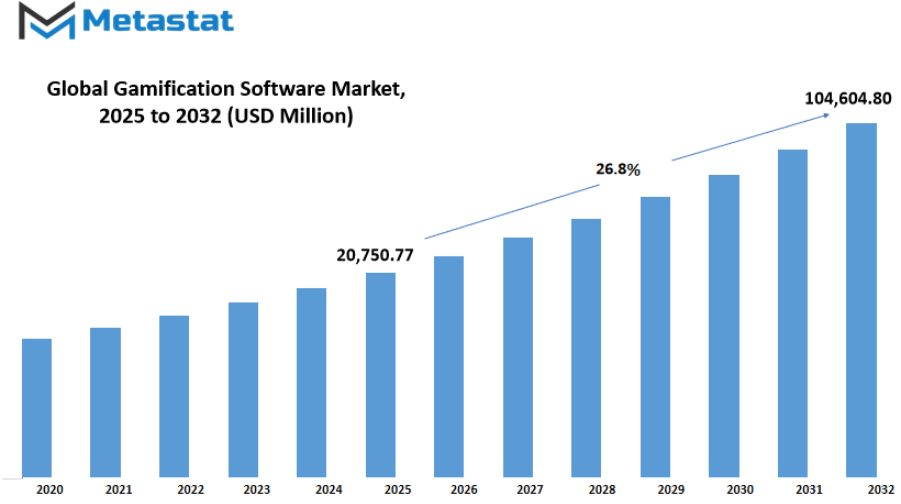
GROWTH FACTOR
The global gamification software market is becoming increasingly popular as companies and schools seek to find new means of making their processes more enjoyable and effective. Companies in diverse industries are coming across that traditional techniques hardly ever control to preserve interest and motivation going, specially for personnel and college students. Gamification fills the gap by using offering sport-like functions like factors, rewards, and demanding situations, that can make mundane responsibilities enticing. This growing appetite for interactive and interesting answers is compelling organizations to use gamification in their employee engagement applications. It is also speedy turning into a vital device for establishments trying to boom productiveness with greater attractive work.
Education and education industries also are seeing gamification turn out to be popular, thanks to its effectiveness in improving mastering results. Traditional methods of getting to know can, at instances, be repetitive, ensuing in reduced attention and retention. Gamification studying platforms address this through adding exciting factors that engage inexperienced persons inside the method. From quizzes to success badges, these structures make getting to know not only powerful however exciting too. This trend is certain to persist as establishments and corporate running shoes are searching for new answers that could meet the needs of a generation-friendly era, promising improved know-how retention and engagement.
But the market is not without its pitfalls. One of the most significant roadblocks is the lack of awareness among conventional enterprises regarding what gamification can do for them. Most organizations view it as an avoidable expenditure instead of a worthwhile investment. In addition to this, the high upfront costs of implementation and customizations can deter small businesses from embracing these solutions. For many such firms, the cost of implementing gamification within their systems seems too high, impeding its entry in some market segments.
These challenges notwithstanding, the prospects for gamification software are bright. Its integration with advanced technologies like artificial intelligence and analytics is creating windows of opportunity for adaptive and individualized experiences. These advances will enable systems to study user activity and customize activities to fit individual tastes, making interaction more effective than ever before. As businesses seek new ways to stimulate their workforce and educators look for improved learning tools, gamification software will be at the center of defining the future of the professional and academic world. This blend of interactivity and personalization will make the technology even more desirable, pointing the way towards rapid growth in the years ahead.
MARKET SEGMENTATION
By Platform
The global gamification software market is picking up pace as companies and organizations search for innovative means of stimulating users and improving performance. Gamification introduces game-like elements like points, rewards, and challenges into environments that are not games, making common things more interactive and inspiring. It runs the gamut from education and fitness apps to employee training and customer engagement programs and is making a significant difference across sectors. Demand for the solutions keeps increasing as businesses realize how engaging tasks can dramatically boost participation and results.
A key motivator for this shift is the increased adoption of digital platforms in both organizational and consumer spaces. Businesses are spending money on gamified solutions to enhance productivity, enhance learning, and increase customer retention. Staff perform better with tasks that are deemed rewarding and interactive, and customers value brands that present interesting experiences. This has compelled companies to embrace gamification software in their digital transformation initiatives, seeking to establish spaces where users become part of a shared entity and want to work toward objectives.
In the market, platforms are crucial to providing such experiences. The platform segment is also split into two categories: open platforms and closed or enterprise platforms. Open platforms, with a worth of $7,828.23 million, support customization and integration with other systems by developers and firms, giving them maximum flexibility across various sectors. Organizations that wish to have greater control and autonomy in their gamification efforts favor these platforms. Conversely, closed or enterprise platforms are meant for very specific business purposes, providing structured solutions that are simpler to control and integrate across internal processes. Both, however, have different uses but help in the overall development of the market.
With extra industries adopting gamification, opposition is intensifying among companies. Firms are concentrating on incorporating superior skills like actual-time analytics, custom designed demanding situations, and ease of integration with cell devices. These enhancements make gamification greater effective via permitting agencies to reveal progress and modify strategies to gain advanced results. It isn't always pretty much developing attractive sports however also imparting measurable consequences like multiplied engagement, better overall performance, and accelerated emblem loyalty.
The global gamification software market is shiny as generation advances and users' expectancies increase. Companies will continue to are looking for new strategies of enticing human beings, and gamification could be an imperative part of this pursuit. Whether to inspire personnel, hold customers on board, or get students mastering, the affect of recreation-like elements can even define digital engagement throughout industries globally.
By Deployment Type
The global gamification software market is experiencing high call for as companies keep to seek new strategies of attractive users, employees, and clients. Gamification represents using recreation-like mechanics like points, rewards, and leaderboards in non-gaming environments to decorate participation and motivation. With organizations emphasizing the enhancement of productiveness and user enjoy, this software has confirmed to be a feasible answer for corporations in industries like schooling, healthcare, retail, and company. The growing awareness on digital transformation and interactive answers has set up gamification as a worthy device for reinforcing engagement and overall performance.
Based on deployment type, the market has been segmented into cloud-based and on-premise solutions, both of which have their own set of advantages. Cloud-based gamification software has picked up a lot of pace with its flexibility, scalability, and reduced initial costs. Companies favor cloud solutions because they offer convenient access from various locations and devices without the requirement of large infrastructures. This is a most sought-after technique by companies that desire to implement gamification at an accelerated pace and lower expenses with automatic updates and less maintenance burden. With remote working and online education becoming increasingly prevalent, cloud-based deployment shall continue to be the leading trend.
Conversely, organizations that emphasize more control and security over their data use on-premise gamification solutions. The software is installed in the infrastructure of the company, and therefore businesses have complete control of the software as well as its customization. On-premise solutions may need greater initial investment and maintenance but are used by industries like finance and government where privacy of the data is of utmost importance. This deployment method is also appropriate for organizations with stringent compliance needs or those in areas with poor internet connectivity.
Both deployment models have their place in the future of the global gamification software market. The decision most often lies on whether the organization is large or small, budget, security requirements, and technical capabilities.As corporations continue to realize the cost of gamification in boosting motivation and delivering results, each cloud-based totally and on-premise answers will call for extra interest. Balancing flexibility and control ensures that the marketplace will aid numerous business desires, establishing the door for vendors to offer customized answers across diverse industries and packages.
By Application
The global gamification software market is gaining reputation as corporations preserve trying to find progressive manner to encourage their employees and customers. Gamification is the application of recreation mechanics in non-sport contexts to power participation, studying, and motivation. Businesses are an increasing number of enforcing such answers to enhance employee productivity, enhance customer loyalty, and growth income. With the growth of technology and growing net penetration, gamification software is becoming a feasible device for numerous industries, which include education, healthcare, retail, and company education. The phenomenon isn't always simply a count number of incorporating a laugh functions; it is about building substantive interactions that compel customers to remain engaged and attain desired results.
Based on application, the global gamification software market is usually categorized into huge corporations and small and medium-sized companies (SMEs). Large organizations have been at the forefront of gamification software program adoption because they could have enough money to invest in sophisticated structures and comprise them into elaborate enterprise tactics. These groups have a tendency to make use of gamification strategies for employee training, enhancing inner collaboration, and maintaining high ranges of engagement in a competitive place of business. For example, performance monitoring and reward applications within huge companies prompt employees to satisfy goals whilst being awarded and preferred for his or her work. The scalability of those solutions additionally makes them an ideal in shape for global groups, where it's miles important to have consistent interaction across geographies.
Then again, SMEs are turning out to be a robust segment for the global gamification software market. Though they might have lower budgets than large corporates, SMEs are seeing the worth in gamification in terms of building customer relationships and enhancing worker retention. Affordable and simple-to-deploy gamification solutions are enabling smaller companies to compete by building interactive experiences for customers and employees. For instance, retail SMEs usually employ loyalty schemes and reward-based apps to engage repeat customers and induce bigger spends. The ease and affordability of contemporary gamification platforms are fueling uptake among such companies.
Total growth of this market will still be driven by the rising need for digital interaction in both types of businesses. Large-scale companies will continue to use sophisticated tools for strategic functions, whereas SMEs will aim to utilize solutions offering rapid and quantifiable outcomes without heavy financial burden. As technology evolves and gamification solutions become more and more customizable, the distinction between large-scale and small-scale adoption will diminish, making it possible for companies of every size to make the most of interactive, game-like activities that serve their business goals.
By End-user
Gamification software has come to be more famous as agencies and agencies searching for precise strategies to have interaction customers, encourage personnel, and boost purchaser loyalty. Gamification software program applies recreation-like functions including points, badges, and leaderboards to make venture of completion greater interesting. The call for for gamification is on the upward push since it ensures better productivity and makes life extra interactive in non-public and paintings environments. Various industries have embraced gamification in their own unique way depending on their goals and target market.
In retail, gamification is famous for purchaser acquisition and retention. Reward points, demanding situations, and tasty campaigns are usually employed by brands to inspire consumers to shop and create loyalty. For instance, loyalty schemes that praise clients with badges or reductions upon accomplishment of particular sports maintain customers for an prolonged period of time. Similarly, in banking, gamification is used to teach customers about monetary products and encourage higher cash control behavior. By turning monetary training into interactive games, banks are making getting to know about investments, financial savings, and credit score greater attractive to customers.
Government agencies are also employing gamification to decorate citizen engagement and focus. Public attention campaigns automatically characteristic interactive tools that reward the consumer for obtaining information about protection, fitness, or environmental topics. In medication, gamification is turning into an powerful manner of encouraging wholesome behavior. Mobile apps that monitor exercise, eating, and taking medication employ game mechanics to encourage patients to maintain activity. The practice has become widely popular as individuals seek enjoyable and easy ways to maintain good health.
Learning and research institutions have taken to gamification to enhance enjoyment of learning. Gamified learning environments enable students to earn points and advance levels as they finish lessons, making the experience less stressful but more thrilling. Gamification assists employee training and customer interaction in IT and telecommunication. Businesses use it to teach employees on new era, at the same time as clients experience interactive stories that simplify complicated services. Other industries, consisting of production and corporate agencies, are also embracing gamification to enhance performance, beautify motivation, and make approaches greater consumer-pleasant.
The w global gamification software market is growing as it is able to be applied throughout a couple of stop-consumer verticals along with retail, banking, authorities, healthcare, schooling, IT, and so forth. Each area applies it in a exceptional manner, but with the identical goal—increasing engagement and yielding better outcomes. As institutions and companies continue to concentrate on customer experience and employee productivity, gamification will continue to be a significant force for driving motivation and delivering value to different industries.
|
Forecast Period |
2025-2032 |
|
Market Size in 2025 |
$20,750.77 million |
|
Market Size by 2032 |
$104,604.80 Million |
|
Growth Rate from 2025 to 2032 |
26.8% |
|
Base Year |
2024 |
|
Regions Covered |
North America, Europe, Asia-Pacific Green, South America, Middle East & Africa |
REGIONAL ANALYSIS
The global gamification software market exhibits immense diversity when viewed from its regional segmentation. North America is a prominent region, with high technology firm presence and digital solution adoption contributing to this growth. The highest regional contribution comes from the United States, given its mature infrastructure and increasing demand for customer interaction solutions among businesses. Canada and Mexico also add to this growth as more investment in digital transformation and innovative learning platforms makes North America a key influencer in driving the market.
Europe has the demand growing for gamification software as organizations seek to improve user experience as well as employee productivity. The UK, Germany, France, and Italy lead, embracing gamification approaches in corporate training, education, and marketing. The area is witnessing consistent growth as businesses incorporate these solutions in employee engagement and customer loyalty programs. Although Western Europe is at the forefront of adopting them, other regions in the area are increasingly adopting such solutions as businesses realize the potential of engaging and motivational systems.
Asia-Pacific is an emerging market due to the proliferation of mobile applications and digitalization of companies. These nations, including India, China, Japan, and South Korea, are spending a lot on gamification for industries like education, retail, and corporate training. The growing strength of the population using the internet and the popularity of smartphone usage in these nations provide a perfect setting for gamification platforms to grow. Startups as well as large-scale companies in this region are actively launching new solutions, which will play a huge role in the growth of the market in the future.
South America and Middle East & Africa also demonstrate good prospects for the gamification software market. In South America, Brazil and Argentina lead the region, with an emphasis on streamlining business processes and enhancing user interaction using new digital technologies. In the Middle East & Africa, GCC countries, Egypt, and South Africa are progressively making investments in technology-based solutions. While these areas remain in the process of development as far as digital infrastructure is concerned, their interest in gamification indicates a healthy scope for growth in the near future.
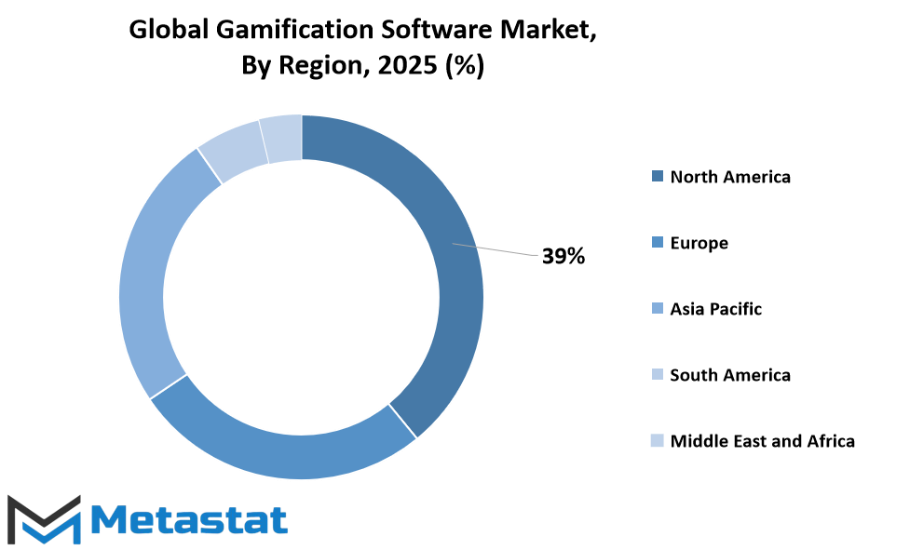
COMPETITIVE PLAYERS
The global gamification software market is attracting attention as companies seek innovative means of enhancing engagement and productivity. Gamification software employs game-like mechanisms like points, badges, and leaderboards to engage users and build participation. Firms in various sectors are implementing these solutions to enhance employee performance, customer loyalty, and user experience in general. The growing need for improved engagement solutions in workplaces and customer-facing interfaces will persistently continue to fuel the use of gamification software in the next few years.
Companies are adopting gamification because it makes routine tasks more engaging and rewarding. This method not only improves the involvement of employees but also helps with learning and development as it makes training sessions more interesting. Companies are discovering that workers work more efficiently when they are engaged, and gamification offers an easy yet efficient means to do that. In the same way, brands employ such tools to foster stronger customer relationships by compensating for participation and loyalty and ultimately in keeping them for the long term.
There is a large number of companies that deal in gamification software and provide various tools and platforms for various requirements. Major players are Centrical, Influitive, LevelEleven, Cool Tabs, Agile CRM, SmartWinnr, Inc, Funifier Inc., CRMGamified, Qstream, Inc., Zoho Corporation, Salesscreen, Ambition, Spinify, Arcade, OneUp Sales, Xoxoday Compass, CloudApps Limited, and Plecto ApS. Each of these firms offers distinct solutions meant to enhance engagement, be it sales performance measurement, employee reward, or customer loyalty schemes. Their solutions address small business and large corporation needs, so gamification becomes available to many organizations.
The industry will continue to expand as digital transformation and remote work trends increase. Companies seek solutions that maintain employees' engagement, motivation, and concentration even when working remotely. Gamification fits the bill by instilling a feeling of accomplishment and positive competition among team members. As technology continues to evolve, more personalized and data-based gamification experiences will be expected, further increasing the value of these solutions for organizations in every industry. This growing significance of engagement strategies guarantees that gamification software will continue to be a priority for businesses trying to maximize productivity and customer loyalty in the coming years.
Gamification Software Market Key Segments:
By Platform
- Open Platform
- Closed/ Enterprise Platform
By Deployment Type
- Cloud-based
- On-Premise
By Application
- Large enterprises
- SMEs
By End-user Vertical
- Retail
- Banking
- Government
- Healthcare
- Education and Research
- IT and Telecom
- Other End-user Verticals
Key Global Gamification Software Industry Players
- Centrical
- Influitive
- LevelEleven
- Cool Tabs
- Agile CRM
- SmartWinnr, Inc
- Funifier Inc.
- CRMGamified
- Qstream, Inc.
- Zoho Corporation
- Salesscreen
- Ambition
- Spinify
- Arcade
- OneUp Sales
- Xoxoday Compass
- CloudApps Limited
- Plecto ApS
WHAT REPORT PROVIDES
- Full in-depth analysis of the parent Industry
- Important changes in market and its dynamics
- Segmentation details of the market
- Former, on-going, and projected market analysis in terms of volume and value
- Assessment of niche industry developments
- Market share analysis
- Key strategies of major players
- Emerging segments and regional growth potential



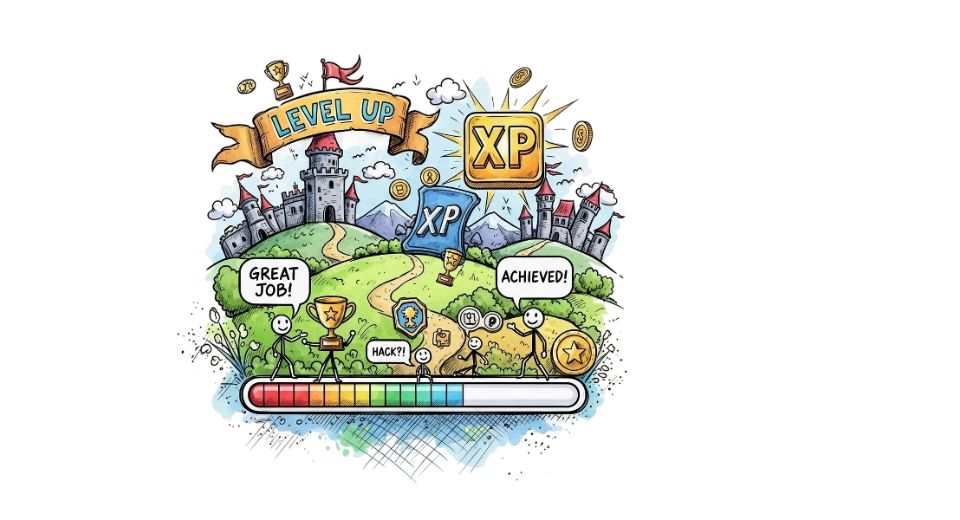
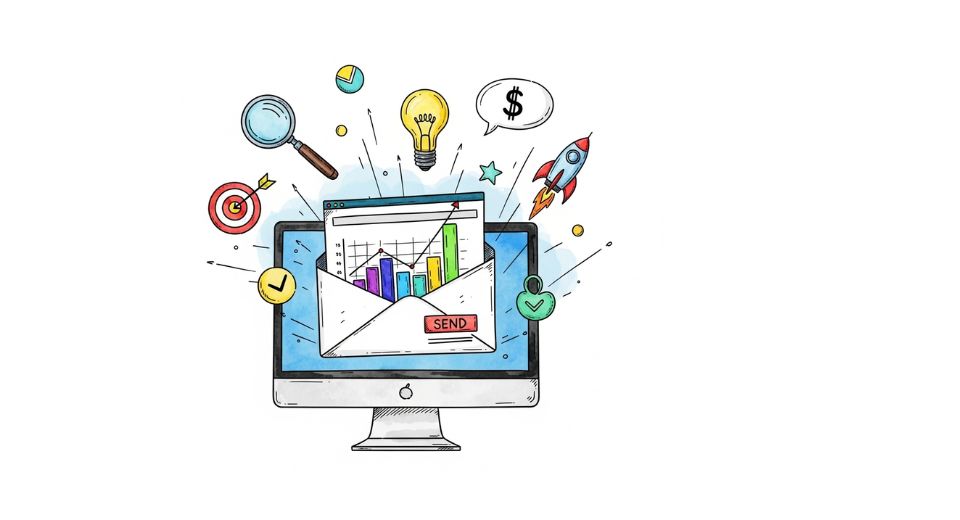
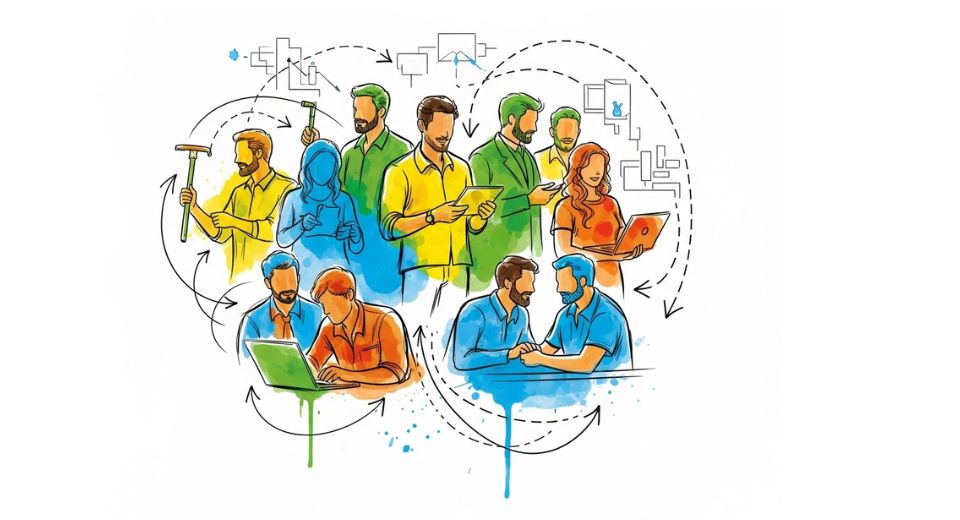
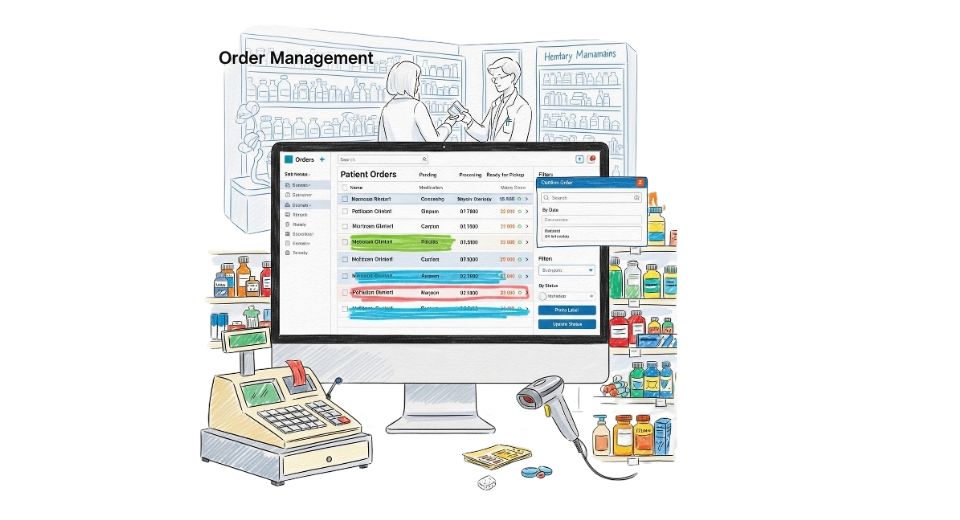

 US: +1 3023308252
US: +1 3023308252






